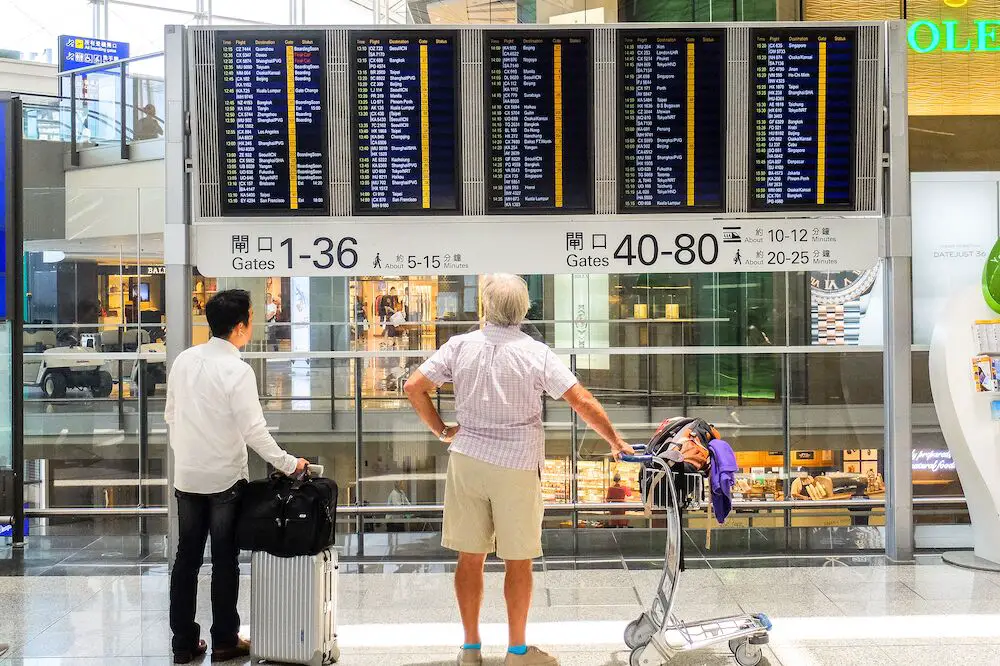Layover vs stopover? Are they the same thing?
In short, they are both related to connecting flights, and both are stops between flights. You see, if you are flying not directly but through some other places, these are connecting flights. And the stop between your flights is called either a layover or stopover. In this article we will talk about the differences.
Flight delay? Cancellation? Denied boarding? File a claim online.

1. Layover vs Stopover
Stopover vs layover?
Before we start, here’s a simplified definition of layover and stopover. Flight layover is a stop between flights. And stopover is a long layover.
Flight layover is a stop between connecting flights. That’s why sometimes people call them flights with a layover. And stopover is a long layover.
1.1 Length (Main Difference)
Layovers are short, stopovers – longer.
Layovers are usually 2, 3, 5, 8-hours long. Maximum duration of an international layer is 23 hours and 59 minutes (up to 24 hours or 1 day). At the same time, it’s common to have a 2 or 3-day long stopover. That affects the total length of a journey. And that is the biggest difference between layover and stopover flights.
1.2 Leaving / Staying at Airport
With layovers everyone do as they wish.
Some travelers choose to leave the airport during a layover, while others choose to stay. You may decide to stay also because otherwise you may need a visa for a connection. Everyone does as they wish / can.
But with stopovers most leave the airport.
They leave the airport to explore the city.
1.3 You Choose to Have a Stopover
Mostly people choose to have a stopover.
If you book a connecting flight, not self-transfer flights, it’s almost impossible to book a stopover by accident. The main reasons people book stopovers are to explore a new place on the way to their destination, or to make a long and exhausting journey less tiring.
1.4 Price Difference
Airline-protected connecting flights and multi-city flights
Sometimes there isn’t any difference.
Sometimes having a stopover on the way to your “real destination” doesn’t cost anything extra. Hence, it can also be a very smart choice to have a stopover. No matter why you decide to do so — either to explore a new place, to have a rest in between flights or to save money.
Sometimes you may also get free perks (see here).
Self-transfer flights
With self-transfer flights, it’s often cheaper to have a stop. When compared to buying a direct flight to your destination.

2. Airline-Protected Connecting Flights vs Self-Transfer Flights
Here are few of the most popular scenarious.
2.1 Layover (Airline-Protected Connecting Flights)
You simply book an airline-protected connecting flight.
Sometimes you can choose between different options – with shorter or longer layover, other times you don’t have a choice. It’s easy to book. It’s safe. If the layover is long enough, you may also decide to leave the airport during a layover.
2.2 Stopover (Airline-Protected Connecting Flights)
You book it as a multi-city flight.
This option is available on the websites of airlines supporting such a feature. In this case, you have the benefits of having an airline-protected connecting flight, while also having a longer stop in between your flights. I have had flights also with 30 and 45-day stopovers. In my case, it also cost less than buying separate flights — so it was a no-brainer.
It’s like a connecting flight with long or very long layovers.
2.3 Layover (Self-Transfer Flights)
Self-transfer flights are separately booked flights.
These are DIY connecting flights. These can be flights with one or several different airlines. Since you book them separately, the length of the stop is up to you — it can be a short layover, or a few day stopover. Just choose what suits you the best and, better, don’t risk with too short layovers.
While with protected connecting flights short layovers are 100% fine, and it may also be beneficial to you (you may get flight compensation, if you miss a connection due to delay), with self transfer short layovers are very risky.
2.4 Stopover (Self-Transfer Flights)
With self transfer, you book flights separately.
And since you book flights separately, the length of the stop is up to you — it can be a short layover, or a few day stopover.
What is your experience with layovers and stopovers? Have you ever had a short layover? Or a 2-day stopover?
About the author:
Kaspars is a digital nomad and travel blogger who’s been traveling the world extensively since 2013. Since 2017, Kaspars has been writing about the less-known aspects of air travel, things like air passenger rights laws and regulations. He’s really good at simplifying complex concepts and making them easily understandable. Kaspars favorite airlines are Qatar Airways and Turkish Airlines.
